Uncover the hidden realm of werewolves in the Bible, where ancient texts hint at transformations that challenge the boundaries of faith and folklore.
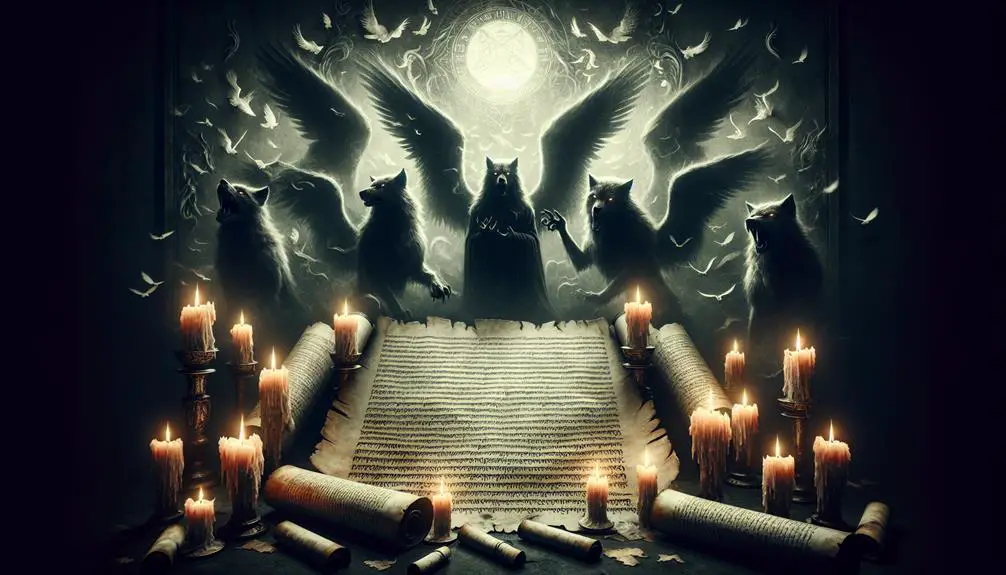
Werewolves in the Bible
In the serene realms of spirituality, you wouldn't expect to encounter the shadowy figure of the werewolf, yet the Bible, with its rich tapestry of stories, might hold more secrets than you've realized.
As you explore the ancient texts, the notion of werewolves lurks in the margins, not explicitly mentioned but suggested through tales of transformation and punishment. The question isn't just about finding these creatures in the scripture but understanding what they symbolize within a theological context.
It's this cryptic intersection of faith and folklore that invites you to look closer, promising insights into how the boundaries of humanity and divinity are navigated in biblical narratives.
Key Takeaways
- The Bible uses animal symbolism to convey complex spiritual truths, not literal werewolves.
- Lycanthropy's roots in mythology and folklore highlight societal fears, not biblical narratives.
- Transformation in the Bible symbolizes spiritual renewal, differing from the physical metamorphosis in werewolf legends.
- Ancient texts' cryptic references to beings like werewolves require careful interpretation, focusing on cultural and theological contexts.
Biblical Creatures and Symbolism
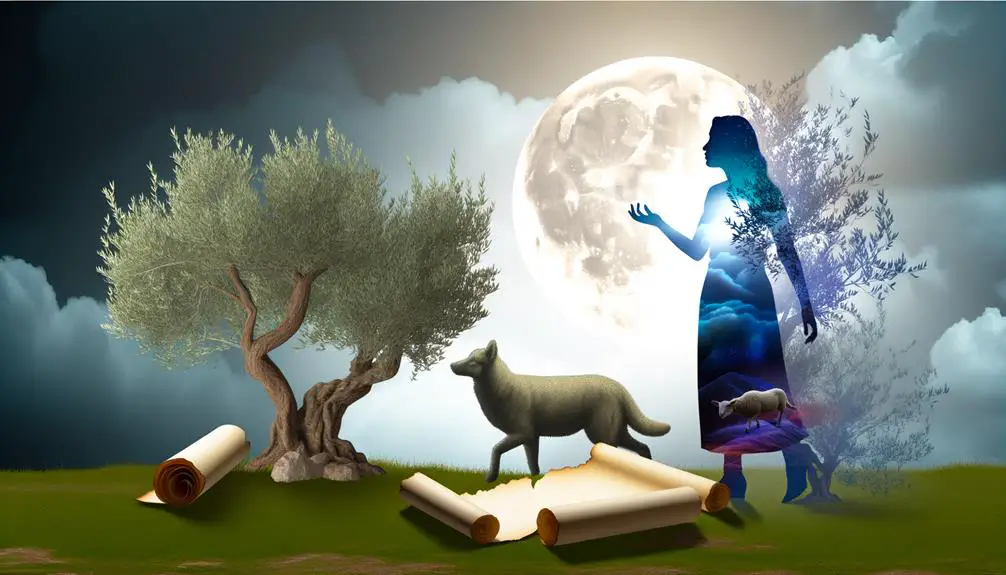
Throughout the Bible, various creatures symbolize complex ideas and principles, revealing deeper layers of meaning within the sacred texts. As you delve into the pages of this ancient anthology, you'll encounter a myriad of symbolic entities, each serving to illuminate spiritual truths and moral lessons. Among these are angelic beings and the infamous Garden serpent, embodiments of the divine and the diabolical that invite a deeper understanding of the Bible's teachings.
Angelic beings, for instance, aren't merely celestial messengers; they represent the direct intervention of God in human affairs. Their appearances and actions signify God's presence, guidance, and sometimes, judgment. They're agents of divine will, emphasizing the connection between the heavenly realm and earthly existence. Their presence in the narrative serves to remind you of the omnipresence of God and the constant interplay between the spiritual and the material worlds.
Conversely, the Garden serpent, introduced in the Genesis narrative, encapsulates the concept of temptation and the fall from grace. This creature's role is critical, as it symbolizes the introduction of sin into the world and the complex relationship between humans and divine commandments. The serpent's cunning conversation with Eve highlights the perennial struggle with temptation, deceit, and the consequences of disobedience. It's a potent symbol of the challenges facing humanity in adhering to moral and spiritual integrity.
These examples illustrate how the Bible employs creatures as symbols to convey profound spiritual truths. Angelic beings and the Garden serpent are but two instances where animal imagery enriches the text, offering layers of meaning that extend beyond their literal existence. Such symbolic use of creatures invites reflection on the broader themes of divine intervention, moral choice, and the human condition.
Lycanthropy: Historical and Cultural Insights
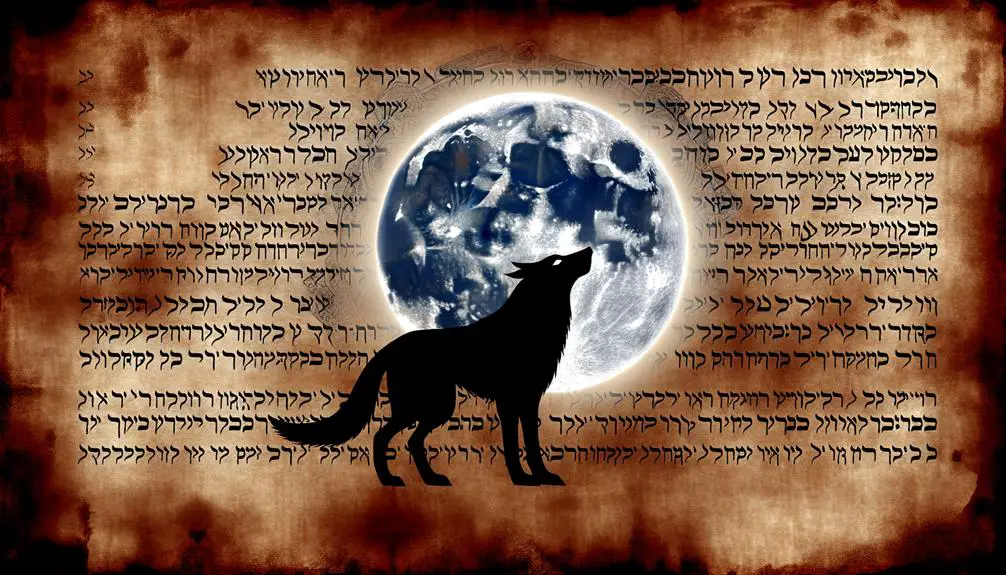
Exploring the realm of biblical creatures and symbolism further, we now turn our attention to the fascinating concept of lycanthropy, offering historical and cultural insights into this phenomenon. Lycanthropy, the transformation of a human into a wolf, traces its roots deep into ancient civilizations, most notably through Greek mythology and Medieval folklore, painting a rich tapestry of belief and superstition that spans centuries.
Greek mythology introduces lycanthropy through the tale of Lycaon, a king transformed into a wolf by Zeus as punishment for his impiety. This myth not only illustrates the believed capacity for humans to metamorphose into animals but also serves as a moral lesson on the wrath of the gods toward human hubris. It's a clear reflection of how ancient cultures intertwined myth with behavioral norms, embedding lycanthropy within a framework of divine retribution and moral caution.
As you delve into Medieval folklore, lycanthropy evolves, reflecting the fears and societal anxieties of the time. In this era, werewolves are often depicted as malevolent beings, associated with witchcraft and the devil, a stark contrast to their divine punishment origins in Greek mythology. This shift underscores the changing perceptions of lycanthropy, from a divine-induced transformation to a curse or affliction, often linked to maleficium.
These historical and cultural insights into lycanthropy demonstrate its multifaceted nature, evolving from ancient myth to medieval superstition. They highlight how lycanthropy has been used as a narrative tool to explore themes of transformation, morality, and the human condition, deeply ingrained in the folklore and mythology of diverse cultures.
Theological Interpretations of Transformation

As we delve into the theological interpretations of transformation, it's crucial to recognize how religious texts and doctrines have historically framed this phenomenon within a spiritual and moral context. The concept of transformation, particularly in the form of divine metamorphosis and spiritual rebirth, occupies a notable position in theological discourse. These transformations aren't merely physical alterations but signify profound spiritual renewals or judgment.
Divine metamorphosis, as observed in sacred narratives, often symbolizes a transition from a state of imperfection or sinfulness to one of enlightenment or grace. This process isn't just a change in form but an internal spiritual journey that reflects a deeper, moral transformation. It's a manifestation of divine intervention or favor, where the divine essence alters the individual's nature for a higher purpose.
Similarly, the idea of spiritual rebirth is central to understanding theological interpretations of transformation. It represents a fundamental change in one's identity and purpose, brought about through divine influence. This rebirth is a departure from the old self, characterized by moral or spiritual failings, towards a new self that embodies virtue, purity, or divine will.
These theological concepts underscore the belief that true transformation is more than a physical phenomenon; it's a profound spiritual awakening or realization, facilitated by divine power. Such transformations are laden with moral implications, emphasizing the journey towards spiritual enlightenment, redemption, or fulfillment of divine purpose. They offer insights into how theological narratives use the motif of transformation to convey messages of hope, moral rectitude, and the possibility of salvation.
Cryptic References and Ancient Texts
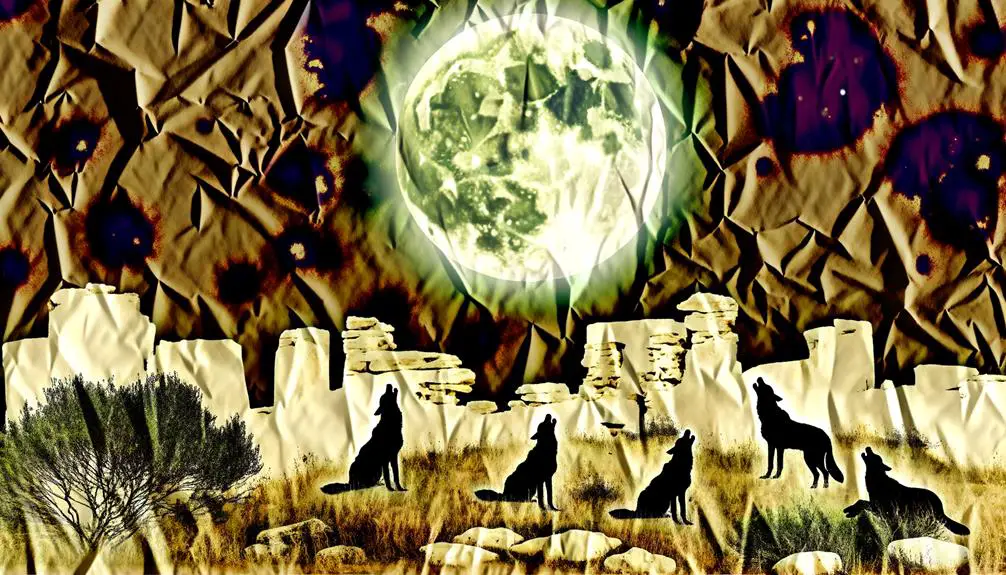
Numerous ancient texts, including some with cryptic references, hint at the existence of beings akin to werewolves, suggesting a complex interplay between myth, religion, and societal values. These documents, often shrouded in the mystery of bygone languages and symbols, present significant translation challenges. Scholars painstakingly decode these texts, aiming to uncover the truths entangled within their narratives. The effort to interpret these ancient references isn't merely an academic pursuit but a quest to understand the human fascination with transformation and the otherworldly.
The cryptic nature of these references raises questions about the accuracy of translations and the potential for misunderstanding. Each word is weighed carefully, with scholars debating the nuances of ancient languages and the context in which these texts were written. The difficulty in translation lies not only in the language barrier but in bridging the vast cultural and temporal divides between the texts' origins and contemporary understanding.
Mythological parallels further enrich the analysis of these ancient texts. Comparisons with other cultures' myths reveal common themes of transformation, often reflecting societal fears and desires. The figure of the werewolf, or beings similar to it, appears across different civilizations, suggesting a universal fascination with the idea of humans transforming into beasts. These parallels provide a broader context for interpreting the cryptic references found in ancient texts, offering insights into the human psyche across ages.
In exploring these ancient and cryptic references, you're delving into a rich tapestry of human belief and myth, piecing together how societies have grappled with the concept of monstrous transformation. This scholarly journey not only illuminates the past but also sheds light on the enduring allure of the werewolf myth.
Modern Interpretations and Theological Debate
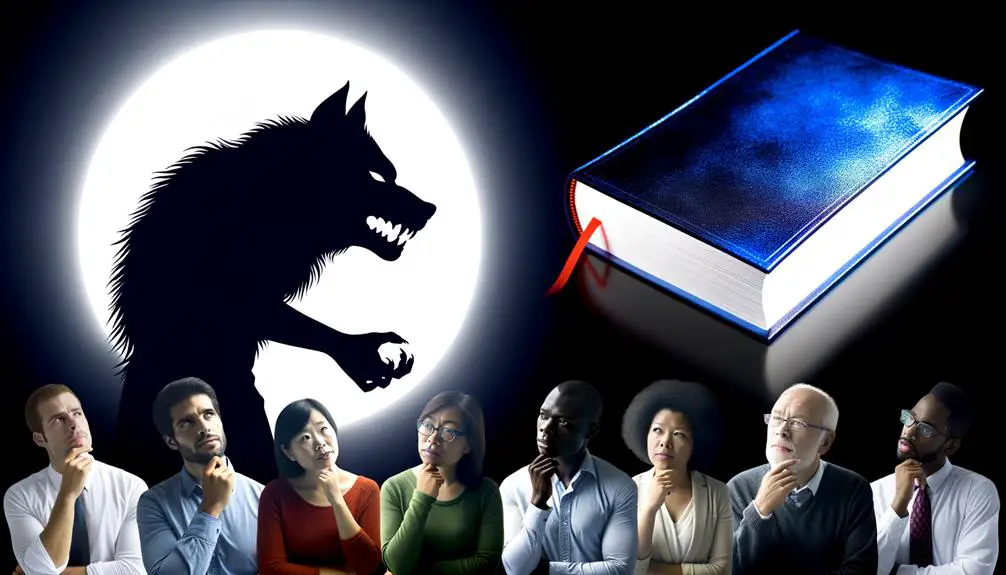
Moving beyond the ancient texts, the debate around werewolves enters the realm of modern interpretations and theological discussions, challenging scholars to reconcile these myths with contemporary beliefs. You're now navigating a landscape where the lines between historical allegories and literal interpretations blur, leading to enriching yet complex conversations on supernatural ethics and the representation of evil in religious texts. The concept of werewolves, while seemingly fantastical, serves as a medium for exploring deeper theological and moral questions within a modern context.
- Supernatural ethics: This aspect examines how the transformation from human to werewolf can symbolize the struggle between good and evil inherent within individuals, urging a reevaluation of moral compasses in light of contemporary ethical dilemmas.
- Apocalyptic allegories: Werewolves are often interpreted as symbols of chaos and destruction, echoing apocalyptic themes found in religious texts. This perspective invites a reflection on the nature of salvation and the end times, encouraging a dialogue on how modern society interprets ancient warnings of moral and physical cataclysm.
- Theological reconciliation: The challenge lies in integrating these mythic elements with established religious doctrines, prompting a reimagining of scriptural interpretations to encompass the metaphorical richness of such legends.
Your journey through this theological debate encourages a rethinking of traditional narratives, urging you to consider how ancient myths like that of werewolves can illuminate contemporary discussions on ethics, morality, and the human condition. These modern interpretations invite a deeper engagement with the spiritual texts, revealing layers of meaning that resonate with today's ethical and existential queries.
Frequently Asked Questions
How Has the Perception of Werewolves Evolved in Different Christian Denominations Over the Centuries?
You've noticed that the perception of werewolves has shifted dramatically across Christian denominations over the centuries.
Initially tied to lunar theories and medieval superstitions, these narratives were deeply entwined with fears and moral lessons.
As time progressed, scholarly and theological debates softened or reinforced these beliefs, depending on the context and evolving understandings of scripture and nature.
This evolution reflects broader changes in how these communities interpret myths and integrate science and faith.
Are There Any Specific Prayers or Rituals Mentioned in Christian Tradition to Protect Against Werewolves?
Surfing through history, you'll find that Christian tradition doesn't specifically mention werewolf exorcisms or lunar prayers aimed at protecting against werewolves. While folklore and local customs may hint at rituals, mainstream Christian denominations don't officially endorse such practices.
Analyzing texts and teachings, it's clear that the concept of werewolves is more a cultural artifact than a theological concern, with no direct liturgical actions prescribed for their repulsion or exorcism.
How Do Contemporary Christian Theologians Reconcile the Concept of Werewolves With the Teachings of the Bible?
In addressing how theologians reconcile certain concepts with Biblical teachings, it's crucial to note that theological interpretations often evolve.
Contemporary Christian scholars typically employ modern skepticism when examining supernatural claims. They might argue that these stories, including werewolves, serve as allegories or moral lessons rather than literal truths.
This approach allows them to maintain the integrity of spiritual teachings while acknowledging the progression of societal understanding and scientific knowledge.
In What Ways Have Werewolf Legends Influenced Christian Art and Iconography Throughout History?
Ever wondered how deep the roots of legend weave into our cultural fabric?
Werewolf legends have significantly influenced Christian art and iconography, particularly evident in medieval sculptures and Renaissance paintings.
These depictions often blend the line between the sacred and the profane, embedding the duality of man's nature into religious narratives.
Analyzing these artistic expressions, you'll find a rich tapestry of belief and folklore, intertwining the divine with the mythical.
Can the Belief in Werewolves Be Seen as Compatible With Christian Doctrine, or Is It Considered Heretical?
You're exploring whether belief in werewolves aligns with Christian teachings or is deemed heretical.
It's crucial to consider lycanthropy ethics and biblical allegories in this analysis.
While not directly referenced in scripture, the transformation themes in werewolf lore resonate with biblical narratives of change and redemption.
However, the church historically viewed these beliefs skeptically, often associating them with superstition or heresy rather than valid allegorical interpretations or ethical considerations.
Conclusion
As you delve into the shadows of biblical creatures and the enigma of lycanthropy, it's clear that the line between myth and divine symbolism blurs.
The transformation stories, cryptically nestled within ancient texts, invite a profound theological exploration. In this scholarly journey, you've witnessed how modern debates intertwine with age-old narratives, painting a complex picture of belief and mythology.
Remarkably, these discussions mirror the transformative nature of faith itself, evolving yet anchored in timeless questions of existence and morality.


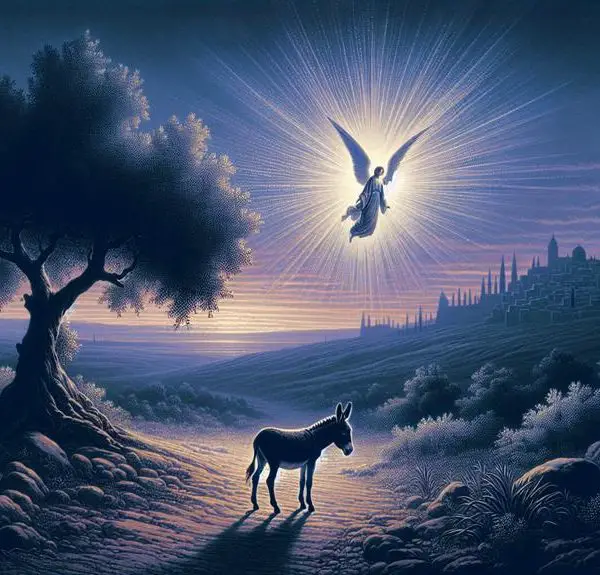
Sign up